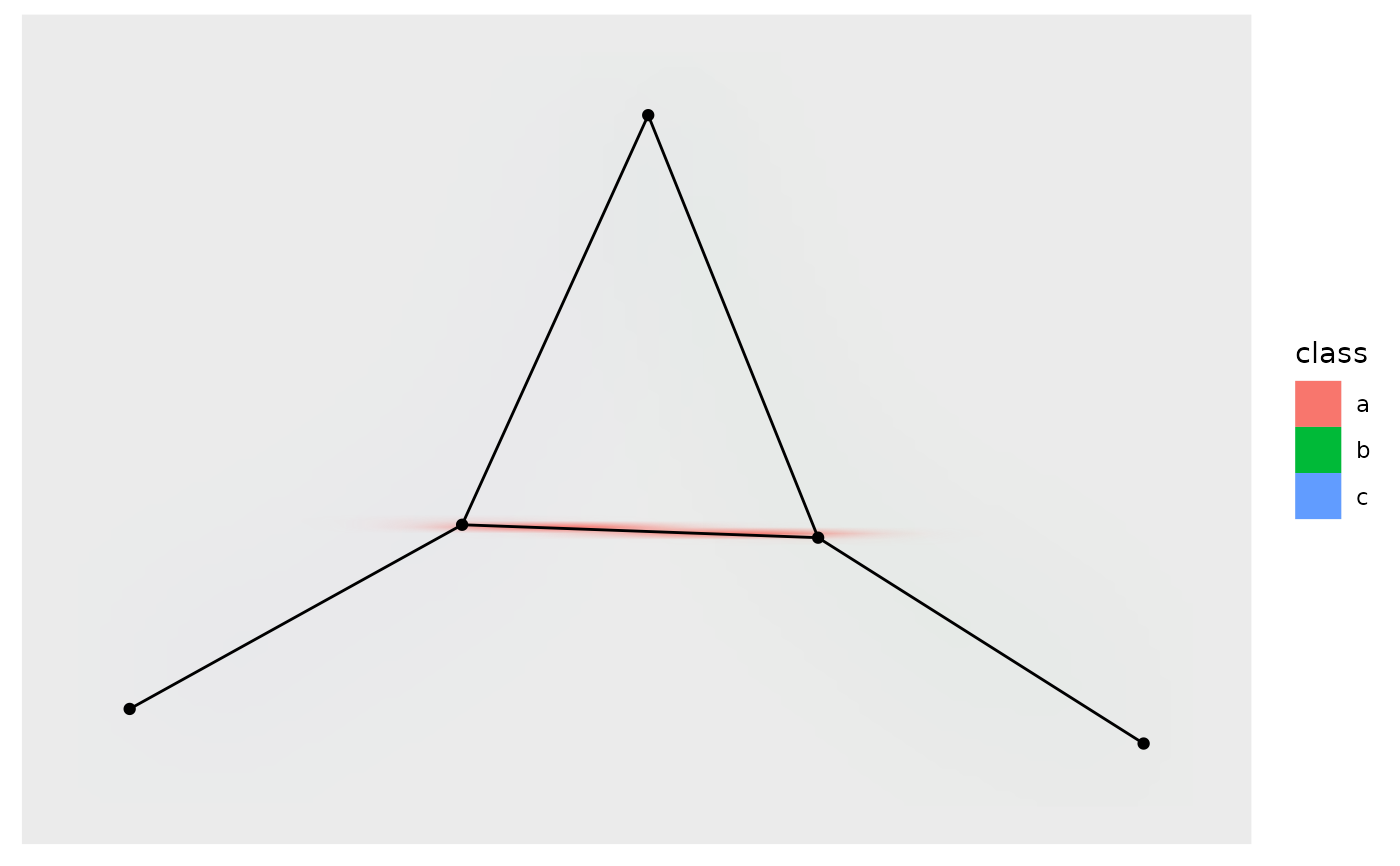This geom makes it possible to add a layer showing edge presence as a density
map. Each edge is converted to n points along the line and a jitter is
applied. Based on this dataset a two-dimensional kernel density estimation is
applied and plotted as a raster image. The density is mapped to the alpha
level, making it possible to map a variable to the fill.
geom_edge_density(
mapping = NULL,
data = get_edges("short"),
position = "identity",
show.legend = NA,
n = 100,
...
)Arguments
- mapping
Set of aesthetic mappings created by
ggplot2::aes()orggplot2::aes_(). By default x, y, xend, yend, group and circular are mapped to x, y, xend, yend, edge.id and circular in the edge data.- data
The return of a call to
get_edges()or a data.frame giving edges in correct format (see details for for guidance on the format). Seeget_edges()for more details on edge extraction.- position
A position adjustment to use on the data for this layer. This can be used in various ways, including to prevent overplotting and improving the display. The
positionargument accepts the following:The result of calling a position function, such as
position_jitter(). This method allows for passing extra arguments to the position.A string naming the position adjustment. To give the position as a string, strip the function name of the
position_prefix. For example, to useposition_jitter(), give the position as"jitter".For more information and other ways to specify the position, see the layer position documentation.
- show.legend
logical. Should this layer be included in the legends?
NA, the default, includes if any aesthetics are mapped.FALSEnever includes, andTRUEalways includes. It can also be a named logical vector to finely select the aesthetics to display. To include legend keys for all levels, even when no data exists, useTRUE. IfNA, all levels are shown in legend, but unobserved levels are omitted.- n
The number of points to estimate in the x and y direction, i.e. the resolution of the raster.
- ...
Other arguments passed on to
layer()'sparamsargument. These arguments broadly fall into one of 4 categories below. Notably, further arguments to thepositionargument, or aesthetics that are required can not be passed through.... Unknown arguments that are not part of the 4 categories below are ignored.Static aesthetics that are not mapped to a scale, but are at a fixed value and apply to the layer as a whole. For example,
colour = "red"orlinewidth = 3. The geom's documentation has an Aesthetics section that lists the available options. The 'required' aesthetics cannot be passed on to theparams. Please note that while passing unmapped aesthetics as vectors is technically possible, the order and required length is not guaranteed to be parallel to the input data.When constructing a layer using a
stat_*()function, the...argument can be used to pass on parameters to thegeompart of the layer. An example of this isstat_density(geom = "area", outline.type = "both"). The geom's documentation lists which parameters it can accept.Inversely, when constructing a layer using a
geom_*()function, the...argument can be used to pass on parameters to thestatpart of the layer. An example of this isgeom_area(stat = "density", adjust = 0.5). The stat's documentation lists which parameters it can accept.The
key_glyphargument oflayer()may also be passed on through.... This can be one of the functions described as key glyphs, to change the display of the layer in the legend.
Aesthetics
geom_edge_density understand the following aesthetics. Bold aesthetics are
automatically set, but can be overwritten.
x y xend yend edge_fill filter
Computed variables
- x, y
The coordinates for each pixel in the raster
- density
The density associated with the pixel
Edge aesthetic name expansion
In order to avoid excessive typing edge aesthetic names are
automatically expanded. Because of this it is not necessary to write
edge_colour within the aes() call as colour will
automatically be renamed appropriately.
See also
Other geom_edge_*:
geom_edge_arc(),
geom_edge_bend(),
geom_edge_bundle_force(),
geom_edge_bundle_minimal(),
geom_edge_bundle_path(),
geom_edge_diagonal(),
geom_edge_elbow(),
geom_edge_fan(),
geom_edge_hive(),
geom_edge_link(),
geom_edge_loop(),
geom_edge_parallel(),
geom_edge_point(),
geom_edge_sf(),
geom_edge_span(),
geom_edge_tile()
Examples
require(tidygraph)
gr <- create_notable('bull') %>%
activate(edges) %>%
mutate(class = sample(letters[1:3], n(), replace = TRUE))
ggraph(gr, 'stress') +
geom_edge_density(aes(fill = class)) +
geom_edge_link() + geom_node_point()
#> Warning: The following aesthetics were dropped during statistical transformation: xend
#> and yend.
#> ℹ This can happen when ggplot fails to infer the correct grouping structure in
#> the data.
#> ℹ Did you forget to specify a `group` aesthetic or to convert a numerical
#> variable into a factor?
#> Warning: Raster pixels are placed at uneven horizontal intervals and will be shifted
#> ℹ Consider using `geom_tile()` instead.
#> Warning: Raster pixels are placed at uneven horizontal intervals and will be shifted
#> ℹ Consider using `geom_tile()` instead.
